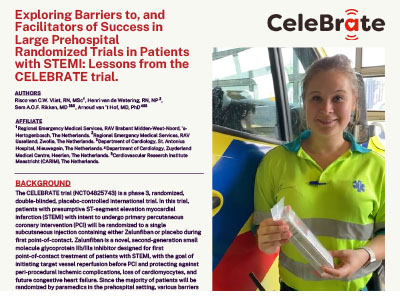ABSTRACTS
Exploring Barriers to and Facilitators of Success in Large Prehospital Randomized Trials in Patients with STEMI: Lessons from the CELEBRATE TrialAuthor: Risco C. W. van Vliet, Henri Wetering, Sem A. O. Rikken, and Arnoud J. W. van’t Hof | | Associate Authors:
Introduction: The CELEBRATE trial (NCT04825743) is a phase 3, randomized, double-blinded, placebo-controlled international trial. In this trial, patients with presumptive ST-segment elevation myocardial infarction (STEMI) with intent to undergo primary percutaneous coronary intervention (PCI) will be randomized to a single subcutaneous injection containing either Zalunfiban or placebo during first point of contact. Zalunfiban is a novel, second-generation small-molecule glycoprotein IIb/IIIa inhibitor designed for first point-of-contact treatment of patients with STEMI, with the goal of initiating target vessel reperfusion before PCI and protecting against periprocedural ischemic complications, loss of cardiomyocytes, and future congestive heart failure. Since the majority of patients will be randomized by paramedics in the prehospital setting, various barriers need to be overcome to execute this trial effectively. Objective: To describe the barriers to successful implementation of prehospital enrollment and therapy and elucidate facilitators conducive to conducting high-quality research in this domain. Methods: We reviewed the practices of ambulance nurses and ambulance study coordinators participating in CELEBRATE to explore self-reported barriers and facilitators that influenced the recruitment of patients by EMS professionals in the prehospital setting. This included examining all actions undertaken at 12 EMS services in the Netherlands participating in CELEBRATE. Although enrollment in CELEBRATE is still ongoing, we analyzed the first 2 years of the study (2021 and 2022). The information was organized into themes to answer the research question. Results: Five main barrier and facilitator themes were identified: training of ambulance personnel, attitude toward scientific research, promotion of quality of care, loss of time treating a seriously ill patient, and initial and sustained motivation. It is of particular note that all five themes can be either a success factor or a barrier to success. Conclusion: Minimizing the barriers and capitalizing on the facilitators of prehospital research are crucial to enhancing efficiency and effectiveness. Addressing challenges such as time constraints, while leveraging factors like training and motivation, is vital for successful trial implementation and the opportunity to test new therapies to improve patient outcomes.
|

